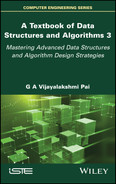Summary of Volume 2
- Preface
- Acknowledgments
- Chapter 8. Trees and Binary Trees
- 8.1. Introduction
- 8.2. Trees: definition and basic terminologies
- 8.2.1. Definition of trees
- 8.2.2. Basic terminologies of trees
- 8.3. Representation of trees
- 8.4. Binary trees: basic terminologies and types
- 8.4.1. Basic terminologies
- 8.4.2. Types of binary trees
- 8.5. Representation of binary trees
- 8.5.1. Array representation of binary trees
- 8.5.2. Linked representation of binary trees
- 8.6. Binary tree traversals
- 8.6.1. Inorder traversal
- 8.6.2. Postorder traversal
- 8.6.3. Preorder traversal
- 8.7. Threaded binary trees
- 8.7.1. Linked representation of a threaded binary tree
- 8.7.2. Growing threaded binary trees
- 8.8. Applications
- 8.8.1. Expression trees
- 8.8.2. Traversals of an expression tree
- 8.8.3. Conversion of infix expression to postfix expression
- 8.8.4. Segment trees
- 8.9. Illustrative problems
- Chapter 9. Graphs
- 9.1. Introduction
- 9.2. Definitions and basic terminologies
- 9.3. Representations of graphs
- 9.3.1. Sequential representation of graphs
- 9.3.2. Linked representation of graphs
- 9.4. Graph traversals
- 9.4.1. Breadth first traversal
- 9.4.2. Depth first traversal
- 9.5. Applications
- 9.5.1. Single source shortest path problem
- 9.5.2. Minimum cost spanning trees
- 9.6. Illustrative problems
- Chapter 10. Binary Search Trees and AVL Trees
- 10.1. Introduction
- 10.2. Binary search trees: definition and operations
- 10.2.1. Definition
- 10.2.2. Representation of a binary search tree
- 10.2.3. Retrieval from a binary search tree
- 10.2.4. Why are binary search tree retrievals more efficient than sequential list retrievals?
- 10.2.5. Insertion into a binary search tree
- 10.2.6. Deletion from a binary search tree
- 10.2.7. Drawbacks of a binary search tree
- 10.2.8. Counting binary search trees
- 10.3. AVL trees: definition and operations
- 10.3.1. Definition
- 10.3.2. Retrieval from an AVL search tree
- 10.3.3. Insertion into an AVL search tree
- 10.3.4. Deletion from an AVL search tree
- 10.3.5. R category rotations associated with the delete operation
- 10.3.6. L category rotations associated with the delete operation
- 10.4. Applications
- 10.4.1. Representation of symbol tables in compiler design
- 10.5. Illustrative problems
- Chapter 11. B Trees and Tries
- 11.1. Introduction
- 11.2. m-way search trees: definition and operations
- 11.2.1. Definition
- 11.2.2. Node structure and representation
- 11.2.3. Searching an m-way search tree
- 11.2.4. Inserting into an m-way search tree
- 11.2.5. Deleting from an m-way search tree
- 11.2.6. Drawbacks of m-way search trees
- 11.3. B trees: definition and operations
- 11.3.1. Definition
- 11.3.2. Searching a B tree of order m
- 11.3.3. Inserting into a B tree of order m
- 11.3.4. Deletion from a B tree of order m
- 11.3.5. Height of a B tree of order m
- 11.4. Tries: definition and operations
- 11.4.1. Definition and representation
- 11.4.2. Searching a trie
- 11.4.3. Insertion into a trie
- 11.4.4. Deletion from a trie
- 11.4.5. Some remarks on tries
- 11.5. Applications
- 11.5.1. File indexing
- 11.5.2. Spell checker
- 11.6. Illustrative problems
- Chapter 12. Red-Black Trees and Splay Trees
- 12.1. Red-black trees
- 12.1.1. Introduction to red-black trees
- 12.1.2. Definition
- 12.1.3. Representation of a red-black tree
- 12.1.4. Searching a red-black tree
- 12.1.5. Inserting into a red-black tree
- 12.1.6. Deleting from a red-black tree
- 12.1.7. Time complexity of search, insert and delete operations on a red-black tree
- 12.2. Splay trees
- 12.2.1. Introduction to splay trees
- 12.2.2. Splay rotations
- 12.2.3. Some remarks on amortized analysis of splay trees
- 12.3. Applications
- 12.4. Illustrative problems
- 12.1. Red-black trees
- References
- Index
..................Content has been hidden....................
You can't read the all page of ebook, please click here login for view all page.
